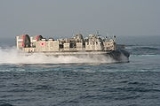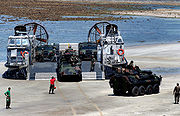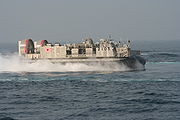
LCAC
Encyclopedia
The Landing Craft Air Cushion (LCAC) is a class of air-cushion vehicle
(hovercraft
) used as landing craft
by the United States Navy
and the Japan Maritime Self-Defense Force
(JMSDF). They transport weapons systems, equipment, cargo and personnel of the assault elements of the Marine Air/Ground Task Force both from ship to shore and across the beach.
hovercraft tested in Vietnam. These two craft confirmed the technical feasibility and operational capability that ultimately led to the production of LCAC. JEFF B was selected as the design basis for today’s LCAC.
 The first 33 were included in the FY82-86 defense budgets, 15 in FY89, 12 each in FY90, FY91 and FY92, while seven were included in FY93. The first LCAC was delivered to the Navy in 1984 and Initial Operational Capability (IOC) was achieved in 1986. Approval for full production was granted in 1987. After an initial 15-craft competitive production contract was awarded to each of two companies, Textron Marine & Land Systems (TMLS) of New Orleans, La, and Avondale Gulfport Marine
The first 33 were included in the FY82-86 defense budgets, 15 in FY89, 12 each in FY90, FY91 and FY92, while seven were included in FY93. The first LCAC was delivered to the Navy in 1984 and Initial Operational Capability (IOC) was achieved in 1986. Approval for full production was granted in 1987. After an initial 15-craft competitive production contract was awarded to each of two companies, Textron Marine & Land Systems (TMLS) of New Orleans, La, and Avondale Gulfport Marine
, TMLS was selected to build the remaining craft. A total of ninety-one LCAC have now been built. The final craft, LCAC 91, was delivered to the U.S. Navy in 2001. This craft served as the basis for the Navy’s LCAC Service Life Extension Program (SLEP).
LCAC first deployed in 1987 aboard . LCAC are transported in and operate from all the U.S. Navy's amphibious-well deck
ships including LHA, LHD, LSD
and LPD
. Ships capable of carrying the LCAC include the "Wasp
" (3), "Tarawa
" (1), "Anchorage
" (4), "Austin
" (1), "Whidbey
" (4-5), and "San Antonio
" (2) classes. All of the planned 91 craft have been delivered to the Navy. Eight minesweeping kits were acquired in 1994-1995. A Service Life Extension Program (SLEP) is currently in progress to add service life to the craft design life of 10 years, delaying the need to replace these versatile craft. 27 were to undergo the SLEP between 2000 and 2007. All 74 are to be completed by 2015. A number of LCACs are currently under development and testing at the Naval Support Activity Panama City
in Panama City, Florida
.
 The craft operates with a crew of five. In addition to beach landing, LCAC provides personnel transport, evacuation support, lane breaching, mine countermeasure operations, and Marine and Special Warfare equipment delivery. The four main engines are all used for lift and all used for main propulsion. They are interchangeable for redundancy. A transport model can seat 180 fully equipped troops. Cargo capacity is 1809 sq ft (168.1 m²). Bow ramp is 28.8 ft (8.8 m) while the stern ramp is 15 ft (4.6 m). Noise and dust levels are high with this craft. If disabled the craft is difficult to tow. In recent years spray suppression has been added to the craft's skirt to reduce interference with driver's vision.
The craft operates with a crew of five. In addition to beach landing, LCAC provides personnel transport, evacuation support, lane breaching, mine countermeasure operations, and Marine and Special Warfare equipment delivery. The four main engines are all used for lift and all used for main propulsion. They are interchangeable for redundancy. A transport model can seat 180 fully equipped troops. Cargo capacity is 1809 sq ft (168.1 m²). Bow ramp is 28.8 ft (8.8 m) while the stern ramp is 15 ft (4.6 m). Noise and dust levels are high with this craft. If disabled the craft is difficult to tow. In recent years spray suppression has been added to the craft's skirt to reduce interference with driver's vision.
According to the USMC the craft can cross 70% of the world's coastlines as opposed to about 15% for conventional landing craft, though the craft has more difficulty in rough seas than a conventional ship.
The US craft are shore based on each coast at Little Creek, Virginia and Camp Pendleton, California. A further ten are on reduced readiness, while two are assigned to research and development, and seven to support roles.
The LCAC will be replaced with the Ship-to-Shore Connector
(SSC), a 73 short ton ACV, starting in 2019.
 Six LCAC are in use by the Japan Maritime Self-Defense Force
Six LCAC are in use by the Japan Maritime Self-Defense Force
. Approval for the sale was given by the United States Government on 8 April 1994. The craft were built by Textron Marine & Land Systems in New Orleans, Louisiana
. Purchase of the first craft was included in the FY93 budget, second in FY95, third in FY99 and fifth and sixth in FY00.

Air-cushioned landing craft
An air cushioned landing craft, also called an LCAC is a modern variation on the amphibious landing boat. These craft are based on small- to mid-sized multi-purpose hovercraft, also known as "over the beach" craft...
(hovercraft
Hovercraft
A hovercraft is a craft capable of traveling over surfaces while supported by a cushion of slow moving, high-pressure air which is ejected against the surface below and contained within a "skirt." Although supported by air, a hovercraft is not considered an aircraft.Hovercraft are used throughout...
) used as landing craft
Landing craft
Landing craft are boats and seagoing vessels used to convey a landing force from the sea to the shore during an amphibious assault. Most renowned are those used to storm the beaches of Normandy, the Mediterranean, and many Pacific islands during WWII...
by the United States Navy
United States Navy
The United States Navy is the naval warfare service branch of the United States Armed Forces and one of the seven uniformed services of the United States. The U.S. Navy is the largest in the world; its battle fleet tonnage is greater than that of the next 13 largest navies combined. The U.S...
and the Japan Maritime Self-Defense Force
Japan Maritime Self-Defense Force
The , or JMSDF, is the naval branch of the Japan Self-Defense Forces, tasked with the naval defense of Japan. It was formed following the dissolution of the Imperial Japanese Navy after World War II....
(JMSDF). They transport weapons systems, equipment, cargo and personnel of the assault elements of the Marine Air/Ground Task Force both from ship to shore and across the beach.
Design and development
Concept design of the present day LCAC began in the early 1970s with the full-scale Amphibious Assault Landing Craft (AALC) test vehicle. During the advanced development stage, two prototypes were built. JEFF A was designed and built by Aerojet General in California, with four rotating ducted propellers. JEFF B was designed and built by Bell Aerospace in New Orleans, Louisiana. JEFF B had two ducted rear propellers similar to the proposed SK-10 which was derived from the previous Bell SK-5 / SR.N5SR.N5
The Saunders-Roe SR.N5 was a medium-sized hovercraft which first flew in 1964. It was the first production-built hovercraft in the world. A later "stretched" variant of the SR.N5 was produced in greater numbers as the SR.N6....
hovercraft tested in Vietnam. These two craft confirmed the technical feasibility and operational capability that ultimately led to the production of LCAC. JEFF B was selected as the design basis for today’s LCAC.

Northrop Grumman Ship Systems
Northrop Grumman Ship Systems was a former sector or division of Northrop Grumman Corporation which was responsible for building small and medium shipping products...
, TMLS was selected to build the remaining craft. A total of ninety-one LCAC have now been built. The final craft, LCAC 91, was delivered to the U.S. Navy in 2001. This craft served as the basis for the Navy’s LCAC Service Life Extension Program (SLEP).
LCAC first deployed in 1987 aboard . LCAC are transported in and operate from all the U.S. Navy's amphibious-well deck
Well deck
A well deck or well dock is a hangar-like deck located at the waterline in the stern of some amphibious warfare ships. By taking on water the ship can lower its stern, flooding the well deck and allowing boats and amphibious landing craft to dock within the ship. This facilitates moving cargo...
ships including LHA, LHD, LSD
Dock landing ship
A Dock landing ship or Landing ship is a form of amphibious warship designed to support amphibious operations. These amphibious assault ships transport and launch amphibious craft and vehicles with their crews and embarked personnel...
and LPD
Amphibious transport dock
An amphibious transport dock, also called a landing platform/dock , is an amphibious warfare ship, a warship that embarks, transports, and lands elements of a landing force for expeditionary warfare missions. Several navies currently operate this kind of ship...
. Ships capable of carrying the LCAC include the "Wasp
Wasp class amphibious assault ship
The Wasp class is a class of Landing Helicopter Dock amphibious assault ships operated by the United States Navy. Based on the Tarawa class, with modifications to operate more advanced aircraft and landing craft, the Wasp class is capable of transporting almost the full strength of a United States...
" (3), "Tarawa
Tarawa class amphibious assault ship
The Tarawa class is a ship class of amphibious assault ships operated by the United States Navy . Five ships were built by Ingalls Shipbuilding between 1971 and 1980; another four ships were planned, but later cancelled...
" (1), "Anchorage
Anchorage class dock landing ship
The Anchorage class dock landing ships were a series of five dock landing ships constructed and commissioned by the United States Navy between 1965 and 1972. US Navy decommissioned all five of them by 2003. They are succeeded by Whidbey Island class LSDs and Harpers Ferry class LSDs.-Ship List: ...
" (4), "Austin
Austin class amphibious transport dock
The Austin class of amphibious transport dock followed theRaleigh class and was followed by the San Antonio classes. Note that some sources consider Cleveland and Trenton ships to be a part of the Austin class, but the Naval Vessel Registry lists them as a separate class.- Ships :-Cleveland...
" (1), "Whidbey
Whidbey Island class dock landing ship
The Whidbey Island class dock landing ship is a dock landing ship of the United States Navy. Introduced to fleet service in 1985, this class of ship features a massive well deck for the transport of four LCAC hovercraft for landing Marines....
" (4-5), and "San Antonio
San Antonio class amphibious transport dock
The San Antonio class is the United States Navy's new primary class of amphibious transport dock in the beginning of the 21st century...
" (2) classes. All of the planned 91 craft have been delivered to the Navy. Eight minesweeping kits were acquired in 1994-1995. A Service Life Extension Program (SLEP) is currently in progress to add service life to the craft design life of 10 years, delaying the need to replace these versatile craft. 27 were to undergo the SLEP between 2000 and 2007. All 74 are to be completed by 2015. A number of LCACs are currently under development and testing at the Naval Support Activity Panama City
Naval Support Activity Panama City
The United States Naval Support Activity Panama City , is located just outside Panama City, Florida and is a United States Navy military base. It is located within Bay County. Among other commands, it houses Naval Surface Warfare Center Panama City Division and the Navy Experimental Diving Unit...
in Panama City, Florida
Panama City, Florida
-Personal income:The median income for a household in the city was $31,572, and the median income for a family was $40,890. Males had a median income of $30,401 versus $21,431 for females. The per capita income for the city was $17,830...
.

According to the USMC the craft can cross 70% of the world's coastlines as opposed to about 15% for conventional landing craft, though the craft has more difficulty in rough seas than a conventional ship.
The US craft are shore based on each coast at Little Creek, Virginia and Camp Pendleton, California. A further ten are on reduced readiness, while two are assigned to research and development, and seven to support roles.
The LCAC will be replaced with the Ship-to-Shore Connector
Ship-to-Shore Connector
The Ship-to-Shore Connector is a system proposed by the US Navy as a replacement for the Landing Craft Air Cushion It will offer increased capacity, to cope with the growing weight of equipment used by the army and marines.-History:...
(SSC), a 73 short ton ACV, starting in 2019.
Japanese operations

Japan Maritime Self-Defense Force
The , or JMSDF, is the naval branch of the Japan Self-Defense Forces, tasked with the naval defense of Japan. It was formed following the dissolution of the Imperial Japanese Navy after World War II....
. Approval for the sale was given by the United States Government on 8 April 1994. The craft were built by Textron Marine & Land Systems in New Orleans, Louisiana
New Orleans, Louisiana
New Orleans is a major United States port and the largest city and metropolitan area in the state of Louisiana. The New Orleans metropolitan area has a population of 1,235,650 as of 2009, the 46th largest in the USA. The New Orleans – Metairie – Bogalusa combined statistical area has a population...
. Purchase of the first craft was included in the FY93 budget, second in FY95, third in FY99 and fifth and sixth in FY00.
Operators
- Japan Maritime Self-Defense ForceJapan Maritime Self-Defense ForceThe , or JMSDF, is the naval branch of the Japan Self-Defense Forces, tasked with the naval defense of Japan. It was formed following the dissolution of the Imperial Japanese Navy after World War II....
(6 units)
- United States NavyUnited States NavyThe United States Navy is the naval warfare service branch of the United States Armed Forces and one of the seven uniformed services of the United States. The U.S. Navy is the largest in the world; its battle fleet tonnage is greater than that of the next 13 largest navies combined. The U.S...
(74 units)- Assault Craft Unit 4
- Assault Craft Unit 5
- South Korean Navy (2 units)
Specifications (LCAC 1)
- Source: LCAC U.S. Navy Fact File

- Builder: Textron Marine and Land Systems/Avondale Gulfport Marine
- Date Deployed: 1982
- Propulsion:
- Legacy: 4 Lycoming/AlliedSignal TF-40B gas turbines (2 for propulsion / 2 for lift); 16,000 hp sustained; 2-shrouded reversible pitch airscrews; 4-double-entry fans, centrifugal or mixed flow (lift)
- SLEP: 4 Vericor Power Systems ETF-40B gas turbines with Full Authority Digital Engine Control
- Length: 87 feet 11 inches (26.4 meters)
- Beam: 47 feet (14.3 meters)
- Displacement: 87.2 tons (88.6 metric tons) light; 170–182 tons (173–185 metric tons) full load
- Speed: 40+ knots (46+ mph; 74 km/h) with full load, 70+ knots maximum speed
- Range: 200 miles at 40 kt (370 km at 75 km/h) with payload
300 miles at 35 kt (550 km at 65 km/h) with payload - Crew: Five
- Load: 60 tons/75 ton overload (54/68 metric tons)
- Military lift: 24 troops or 1 MBT
- Armament: two 12.7 mm machine guns. Gun mounts will support: M2HB .50 cal machine gun; Mk 19 Mod 3 40 mm grenade launcher; M60 machine gunM60 machine gunThe M60 is a family of American general-purpose machine guns firing 7.62×51mm NATO cartridges from a disintegrating belt of M13 links...
. Tests conducted with GAU-13 30mm gatling gun. - Radar: Navigation: Marconi LN-66; I-band

